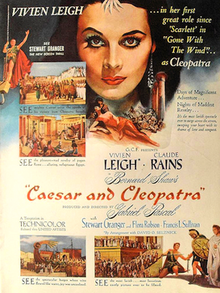Caesar and Cleopatra (film)
| Caesar and Cleopatra | |
|---|---|
 Theatrical release poster | |
| Directed by | Gabriel Pascal |
| Written by | George Bernard Shaw |
| Produced by | Gabriel Pascal |
| Starring | Claude Rains Vivien Leigh |
| Cinematography | Jack Hildyard |
| Edited by | Frederick Wilson Joan Warwick |
| Music by | Georges Auric |
Production company | |
| Distributed by | Eagle-Lion Films (UK) United Artists (US) |
Release dates | 1945 (UK) 1948 (France) |
Running time | 123 minutes |
| Country | United Kingdom |
| Language | English |
| Budget | $5.2 million[1] or £1.3 million[2][3] |
| Box office | $2,250,000 (US rentals)[4] 815,007 admissions (France)[5] $1.4 million (UK)[3] |
Caesar and Cleopatra is a 1945 British Technicolor film directed by Gabriel Pascal and starring Claude Rains and Vivien Leigh.[6] It was adapted from the play Caesar and Cleopatra (1901) by George Bernard Shaw. The film was produced by Independent Producers, Pascal Film Productions, and Eagle-Lion Distributors.[citation needed]
Caesar and Cleopatra was a box office failure, but it was nominated for an Academy Award for Best Art Direction (John Bryan).[7]
Plot
In this philosophical coming-of-age film, an aging Julius Caesar takes possession of the Egyptian capital city of Alexandria, and tries to resolve a feud between young Princess Cleopatra and her younger brother Ptolemy. During the resulting sometimes-murderous court intrigues, Caesar develops a special relationship with Cleopatra, and teaches her how to use her royal power.
Production
Filmed in Technicolor with lavish sets, the production was reported to be the most expensive film ever made in Britain at the time, coming to £1,278,000.[8]
Pascal ordered sand from Egypt to get the right cinematic color. The production also ran into delays due to being filmed during the Second World War.[9] During the shoot, Vivien Leigh tripped and miscarried.[1]
The film was described as a "box office stinker" at the time, and almost ended Pascal's career. It was the first Shaw film made in colour, and the last film version of a Shaw play during his lifetime. After Shaw's death in 1950, Pascal went on to produce one more Shaw derived film, Androcles and the Lion (1952).
Cast
- Claude Rains as Julius Caesar, Roman conqueror.
- Vivien Leigh as Cleopatra, young queen of Egypt.
- Stewart Granger as Apollodorus, a patrician amateur of the arts.
- Flora Robson as Ftatateeta, Cleopatra's nurse, who murders her enemies on command.
- Francis L. Sullivan as Pothinus, Egyptian courtier, tutor and guardian of Cleopatra's brother Ptolemy XIII.
- Basil Sydney as Rufio, Roman general.
- Cecil Parker as Britannus, Brittanic slave to Caesar.
- Stanley Holloway as Belzanor.
- Raymond Lovell as Lucius Septimus, Roman occupier of Egypt.
- Ernest Thesiger as Theodotus, Greek savant.
- Anthony Harvey as Ptolemy, child king of Egypt.
- Leo Genn as bearer of evil tidings
- Jean Simmons as Harpist.
- Michael Rennie as Quayside Centurion.
- Ronald Shiner as Second Porter.
- Roger Moore as Extra (uncredited).
Reception
According to trade papers, the film was a "notable box office attraction" at British cinemas.[10]
The film earned US$1,363,371 in the United States, making it one of the most popular British films ever released there.[11] It did however fall short of initial expectations.[12]
Variety estimated that Rank lost $3 million on the film.[3]
See also
- Cultural depictions of Julius Caesar
- Cultural depictions of Cleopatra VII
- List of films based on military books (pre-1775)
References
- ^ a b Jay S.Steinberg, 'Caesar and Cleopatra', Turner Classic Movies
- ^ "THE LONDON LETTER: Loan Vote Prospects" The Scotsman [Edinburgh, Scotland] 13 Dec 1945: 4.
- ^ a b c "'Cleo' $3,000,000 in the red", Variety, 30 October 1946 p 3
- ^ "60 Top Grossers of 1946", Variety 8 January 1947 p8
- ^ Box office information for Stewart Granger films in France at Box Office Story
- ^ http://ftvdb.bfi.org.uk/sift/title/28453?view=cast
- ^ "NY Times: Caesar and Cleopatra". New York Times. Retrieved 20 December 2008.
- ^ "Noteworthy Films Made In U.K." The West Australian. Perth: National Library of Australia. 17 January 1953. p. 27. Retrieved 4 August 2012.
- ^ Caesar and Cleopatra (1945) home video review, Turner Classic Movies
- ^ Robert Murphy, Realism and Tinsel: Cinema and Society in Britain 1939-48 2003 p209
- ^ Sarah Street, Transatlantic Crossings: British Feature Films in the USA, Continuum, 2002 p 94
- ^ https://archive.org/stream/variety164-1946-11#page/n122/mode/1up/search/8%2C500%2C000
Bibliography
- The Great British Films, pp 97–101, Jerry Vermilye, 1978, Citadel Press, ISBN 0-8065-0661-X
External links
- Caesar and Cleopatra at AllMovie
- Template:BFI Explore
- Caesar and Cleopatra at IMDb
- Caesar and Cleopatra at the TCM Movie Database
- Movie Production Stills 1
- Movie Production Stills 2
- Trailer for Caesar and Cleopatra (Video)
- Gabriel Pascal directs Shaw's 'Caesar and Cleopatra' 1945 on YouTube (Newsreel)
- Film Facts
- Pascal with Jean Simmons at premiere 13 December 1945
- 1945 films
- 1940s romantic comedy films
- British films
- British romantic comedy films
- English-language films
- Cultural depictions of Julius Caesar
- Depictions of Cleopatra on film
- Films based on works by George Bernard Shaw
- Films based on plays
- Films set in ancient Rome
- Films set in Egypt
- United Artists films
- Films directed by Gabriel Pascal
- Films produced by Gabriel Pascal
- Film scores by Georges Auric
